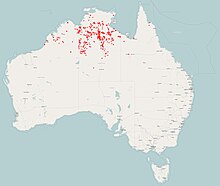Northern nail-tail wallaby
| Northern nail-tail wallaby[1] | |
|---|---|

| |
| Scientific classification | |
| Kingdom: | |
| Phylum: | |
| Class: | |
| Infraclass: | |
| Order: | |
| Family: | |
| Genus: | |
| Species: | O. unguifera
|
| Binomial name | |
| Onychogalea unguifera (Gould, 1841)
| |

| |
| The distribution of the northern nail-tail wallaby Data from The Atlas of Living Australia | |
The northern nail-tail wallaby (Onychogalea unguifera) also known as the sandy nail-tail wallaby, is a species of macropod found in Queensland, Western Australia and Northern Territory. Unlike the bridled nail-tail wallaby (O. fraenata), the northern nail-tail wallaby is not a threatened species.[2] The only other member of the genus, the crescent nail-tail wallaby (O. lunata), is extinct.
The northern nail-tail wallaby by far the largest species in the genus Onychogalea. It is a solitary, nocturnal browser feeding on a variety of foliage. It is a sandy colour, which gave rise to its other common name.[3]
Two subspecies have been defined, but their validity is disputed.
- O. u. unguifera from the northwestern part of its range;
- O. u. annulicauda from the northeastern part of its range.[4]
References
- ^ Groves, C. P. (2005). Wilson, D. E.; Reeder, D. M. (eds.). Mammal Species of the World: A Taxonomic and Geographic Reference (3rd ed.). Baltimore: Johns Hopkins University Press. p. 66. ISBN 0-801-88221-4. OCLC 62265494.
- ^ a b Template:IUCN2008
- ^ Menkhorst, Peter (2001). A Field Guide to the Mammals of Australia. Oxford University Press. p. 124.
- ^ Gordon, G. (1981). "Northern Nailtail Wallaby". In Ronald Strahan (ed.). The Complete Book of Australian Mammals. Angus & Robertson. p. 204.
External links

